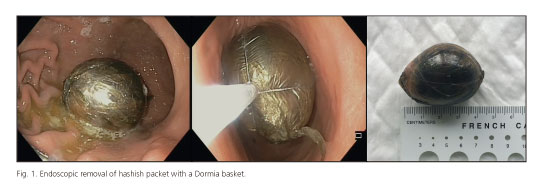My SciELO
Services on Demand
Journal
Article
Indicators
-
 Cited by SciELO
Cited by SciELO -
 Access statistics
Access statistics
Related links
-
 Cited by Google
Cited by Google -
 Similars in
SciELO
Similars in
SciELO -
 Similars in Google
Similars in Google
Share
Revista Española de Enfermedades Digestivas
Print version ISSN 1130-0108
Rev. esp. enferm. dig. vol.109 n.3 Madrid Mar. 2017
https://dx.doi.org/10.17235/reed.2017.4504/2016
LETTERS TO THE EDITOR
Endoscopic removal of a hashish packet
Extracción endoscópica de paquete de hachís
Key words: Body packer. Hashish. Drug. Endoscopy.
Palabras clave: Body packer. Hachís. Droga. Endoscopia.
Dear Editor,
Illicit drug trafficking within the body ("body packers") represents a medical-legal problem currently on the rise. Endoscopic removal of drug packets is not generally recommended (1) because of the risk of packet rupture and subsequent overdose on the spilled substance. However, this may represent an effective alternative to surgery in selected patients (2).
Case report
A 40-year-old male presented with abdominal pain and diaphoresis following the ingestion of 30 g of hashish as a means of illegal trafficking, remaining in police custody during his hospital stay. Abdominal computed tomography (CT) revealed two foreign bodies in the ileum, 4-cm and 3-cm in size, with signs of mechanical obstruction without perforation, which were spontaneously expelled at 24 hours, their nature being confirmed following specific testing. A follow-up CT scan after 48 hours found another foreign body at the gastric antrum, which had not been recognized earlier; this prompted an oral endoscopic procedure that managed to remove a 4-cm round, semi-hard packet using a Dormia basket (Fig. 1). The procedure was uneventful under deep sedation administered by an anesthetist.
Discussion
Endoscopic management of body packers has been described for cases where a single packet (or a small number of packets) fails to cross the pylorus (2,3), as prolonged pressure of the foreign body on the gastric mucosa may result in intoxication, upper gastrointestinal bleeding, and gastric obstruction (4,5). In our patient, the absence of spontaneous progression after 96 hours, and the nature of the substance carried (hashish may diminish consciousness but is usually not life threatening, as opposed to a cocaine or heroine overdose) (3), were key factors in deciding the therapeutic approach.
Aurora Burgos-García, Consuelo Froilán-Torres and Mariana Tavecchia
Department of Digestive Diseases.
Hospital Universitario La Paz. Madrid, Spain
References
1. Birk M, Bauerfeind P, Deprez PH, et al. Removal of foreign bodies in the upper gastrointestinal tract in adults: European Society of Gastrointestinal Endoscopy (ESGE) Clinical Guideline. Endoscopy 2016;48(5):489-96. DOI: 10.1055/s-0042-100456. [ Links ]
2. Shabani M, Zamani N, Hassanian-Moghaddam H. Endoscopic retrieval of baggies in body stuffers. Endosc Int Open 2016;4(4):443-5. DOI: 10.1055/s-0042-103242. [ Links ]
3. Traub S, Hoffman RS, Nelson LS. Body packing: The internal concealment of illicit drugs. N Engl J Med 2003;349;26:2519-26. DOI: 10.1056/NEJMra022719. [ Links ]
4. Küttner Magalhães R, Moreira T, Pimentel R, et al. Drug package as a cause of gastric outlet obstruction. Endoscopy 2012;44(Suppl 2)UCTN:E421. DOI: 10.1055/s-0031-1291696. [ Links ]
5. Dueñas-Laita A, Nogué S, Burillo-Putze G. Body packing. N Engl J Med 2004;350(12):1260-1. [ Links ]











 text in
text in 


